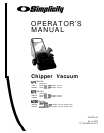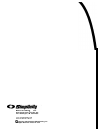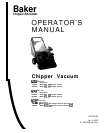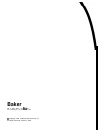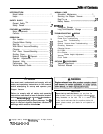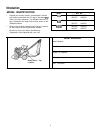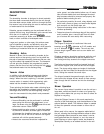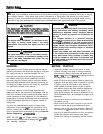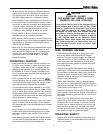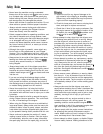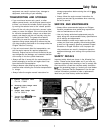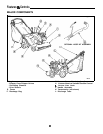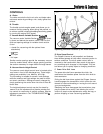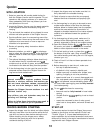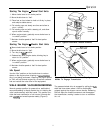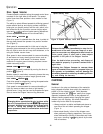
DESCRIPTION
General
The shredding chamber is designed to shred materials
that have been vacuumed directly into the unit through
the extra-wide vacuum intake nozzle or through the flexi-
ble vacuum hose, eliminating the need to manually load
or feed material into the shredder.
Selective vacuum-shredding can be performed with the
optional 20 foot long, large-diameter, quick-connect hose
while the unit is stationary, permitting
precisely-
controlled vacuuming of areas such as flower or shrub
beds, or other confined or landscaped areas.
Large yard, garden, or other open, flat surface areas
can be cleaned up quickly and efficiently using the
Chipper Vacuum’s self-propelled feature, which permits
vacuuming of materials while the unit propels itself.
Shredding Action
Material is drawn into the shredding chamber by the
vacuum action of the spinning rotor, and is pulled into
the path of patented shredding hammers that are rotat-
ing at the same high speed as the rotor. The hammers
cut and grind the material into progressively smaller
pieces, and the flow of air then conveys the fully
shred-
ded,reduced waste into the discharge bag.
Vacuum Action
In addition to the shredding hammers and chipping
knives, the rotor has fan blades integrated into its
design. When the rotor is spinning, a constant, powerful
vacuum action is created, which aggressively pulls
waste into the shredder chamber for shredding.
These spinning fan blades also create a blowing force
that ejects the shredded or chipped material out of the
discharge chute and into the discharge bag, making
room for more material to be pulled in and processed.
Vacuum/Shredding
l Vacuum/Shredding can be performed in confined
areas using the vacuum hose attachment, or on
large, flat areas using the
3-speed
power drive and
extra-wide vacuum intake nozzle.
l Areas containing rocks, gravel, or other hard materi-
als should be avoided, as these types of materials
will damage the shredding hammers or reduce their
service life. Use of the unit to vacuum non-organic
materials will void the product warranty.
l Areas to be vacuumed should be inspected for
rocks, gravel, and other debris before use. All mate-
rials and other debris that could damage the shred-
ding hammers should be removed and properly dis-
posed of before starting the unit.
l Se particularly watchful for small, sharp objects such
as old nails, pieces of glass, and small metal objects
such as cans, can lids, bottle tops, etc.
l Review all operating safety instructions in this manu-
al before proceeding.
l Determine where the discharge bag will be emptied,
and if possible, plan a vacuum path that will allow
you to access this area easily while vacuuming.
Chipper Operation
The chipper is designed to handle tree limbs and
branches up to
2-l/2” in diameter on 5 HP models, and
up to 3” diameter on
13
HP models. The unit can also
process tough organic matter such as corn stalks and
berry canes.
Chipping operations should be performed while the unit
is stationary, and positioned so that the operator has
firm footing and easy access to the chipper cone area.
Tree limbs and branches should be inserted “butt end”
first into the chipper cone, and are fed into the chipper
block. The sharp cutting edges and angle of the blades
actually pull the tree limbs and branches into the chipper
block, cutting the material into small chips.
The chips of material then pass through a slot in the
rotor behind the chipper knives, where air flow conveys
them through the fan chamber and into the discharge
bag.
Blower Operation
The vacuum force makes it possible to use the unit as a
large-area, self-driven blower for clean-up of grass clip-
pings or other debris that you may not want to collect for
disposal or recycling.
Using the Chipper Vacuum in this mode requires the
removal of the discharge bag, and the attachment of the
optional deflector elbow. The deflector elbow is needed
to direct the powerful exhaust stream to either side of
the unit.
When used in this manner, the operator walks behind
the unit, allowing the discharge deflector elbow to blow
the lightweight debris toward an area where it can be
easily gathered later for disposal, or, as in the case of
grass clippings or other organic matter, be allowed to
decompose naturally as an added nutrient for the soil.
3



